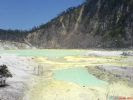Tips on barbecue
Let's become familiar with basic barbecuing techniques makes cooking outdoors over the charcoal grill even more pleasant.
Follow the manufacturer's directions for your grill. If the firebox needs a foundation for the charcoal, you can line the firebox of a brazier-type grill with heavy-duty foil and top it with a one-inch base of pea gravel, coarse grit, or expanded mica insulation pellets. Change the liner when it gets full of greasy dripping. You can wash gravel or grit bedding to dry and use again. Discard insulation pellets. Determine the approximate amount of briquettes you'll need. Small, short-cooking foods need fewer briquettes than thicker meat cuts.
Mound briquettes and start them with liquid lighter or jelly fire starter, following label directions. Or, omit the fuel fire starters and use an electric starter. Don't use gasoline or kerosene! Once started, let the coals burn until they die down to a glow. Arrange the coals with long-handles tongs.
To check, the temperature of the coals, hold your hand, palm side down, above the coals at the distance the food will be cooking. Start counting "one thousand one, one thousand two," etc. If you need to remove your hand after 2 seconds, the coals are Hot; 3 second, Medium-Hot; 4 seconds, Medium; and 5 or 6 seconds; Slow.
As food cooks, control flare-ups by spacing coals farther apart or using a pump-spray bottle filled with water. Don't douse the coals!
Use a meat thermometer to check the doneness of roasts. Insert it so the tip reached the thickest part of the meat, without touching fat, bone or the metal spit rod. Check, the final temperature by pushing the thermometer a little farther into the meat. If the temperature drops, cook longer.
When turning steaks, use tongs to avoid piercing the meat. If you don't have tongs, insert the fork into a strip of fat and flip the steak with the aid of a turner.
The cooking times for chicken, ribs and chops can be shortened with the use of a microwave oven. Just partially micro-cook these foods before placing them on the grill
Follow the manufacturer's directions for your grill. If the firebox needs a foundation for the charcoal, you can line the firebox of a brazier-type grill with heavy-duty foil and top it with a one-inch base of pea gravel, coarse grit, or expanded mica insulation pellets. Change the liner when it gets full of greasy dripping. You can wash gravel or grit bedding to dry and use again. Discard insulation pellets. Determine the approximate amount of briquettes you'll need. Small, short-cooking foods need fewer briquettes than thicker meat cuts.
Mound briquettes and start them with liquid lighter or jelly fire starter, following label directions. Or, omit the fuel fire starters and use an electric starter. Don't use gasoline or kerosene! Once started, let the coals burn until they die down to a glow. Arrange the coals with long-handles tongs.
To check, the temperature of the coals, hold your hand, palm side down, above the coals at the distance the food will be cooking. Start counting "one thousand one, one thousand two," etc. If you need to remove your hand after 2 seconds, the coals are Hot; 3 second, Medium-Hot; 4 seconds, Medium; and 5 or 6 seconds; Slow.
As food cooks, control flare-ups by spacing coals farther apart or using a pump-spray bottle filled with water. Don't douse the coals!
Use a meat thermometer to check the doneness of roasts. Insert it so the tip reached the thickest part of the meat, without touching fat, bone or the metal spit rod. Check, the final temperature by pushing the thermometer a little farther into the meat. If the temperature drops, cook longer.
When turning steaks, use tongs to avoid piercing the meat. If you don't have tongs, insert the fork into a strip of fat and flip the steak with the aid of a turner.
The cooking times for chicken, ribs and chops can be shortened with the use of a microwave oven. Just partially micro-cook these foods before placing them on the grill


Comments
Post a Comment